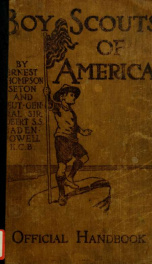Boy Scouts of America

The Boy Scouts of America (BSA) is one of the largest youth organizations in the United States, with over four million youth members in its age-related divisions. Since its founding in 1910 as part of the international Scout Movement, more than 110 million Americans have been members of the BSA.[3] The BSA goal is to train youth in responsible citizenship, character development, and self-reliance through participation in a wide range of outdoor activities, educational programs, and, at older age levels, career-oriented programs in partnership with community organizations. For younger members, the Scout method is part of the program to inculcate typical Scouting values such as trustworthiness, good citizenship, and outdoors skills, through a variety of activities such as camping, aquatics, and hiking.[4][5] The BSA is a constituent member of the World Organization of the Scout Movement. The traditional Scouting divisions are Cub Scouting for boys ages 7–10, Boy Scouting for boys ages 10–17 and Venturing for young men and women ages 14–21. Learning for Life is a non-traditional subsidiary that provides in-school and career education.[1][6] The BSA operates traditional Scouting locally through units sponsored and operated by churches, clubs, civic associations, educational organizations and the like. Units are led entirely by volunteers who are supported by local councils using both paid professionals and volunteers. The influence of Scouting on American society is frequently cited by both its advocates and critics. In addition to nostalgic memories of campfires kindling friendships, prominent leaders in various fields of endeavor have credited the skills they learned in Scouting as helping mold them into successful citizens. Critics have called the BSA's membership obligations unfair, resulting in litigation in various state and federal courts. The progressive movement in the United States was at its height during the early twentieth century.[7] With the migration of families from farms to cities, there were concerns among some people that young men were no longer learning patriotism and individualism. The YMCA was an early promoter of reforms for young men with a focus on social welfare and programs of mental, physical, social and religious development.[8]:72–82 Scouting had two notable predecessors in the United States: the Woodcraft Indians started by Ernest Thompson Seton in 1902 and the Sons of Daniel Boone founded by Daniel Carter Beard in 1905.[9] In 1907, British General Robert Baden-Powell founded the Scouting movement in England using elements of Seton's works.[10] Several small local Scouting programs for boys started independently in the U.S. soon after— most of these later merged with the BSA.[11]:52 In 1909, Chicago publisher W. D. Boyce was visiting London, where he encountered the Unknown Scout and learned of the Scouting movement.[12] Soon after his return to the U.S., Boyce incorporated the Boy Scouts of America on February 8, 1910.[13] Edgar M. Robinson and Lee F. Hanmer became interested in the nascent BSA movement and convinced Boyce to turn the program over to the YMCA for development in April 1910. Robinson enlisted Seton, Beard, Charles A. Eastman and other prominent leaders in the early youth movements. In January 1911, Robinson turned the movement over to James E. West who became the first Chief Scout Executive and Scouting began to expand in the U.S.[8]:148 The BSA's stated purpose at its incorporation in 1910 was "to teach [boys] patriotism, courage, self-reliance, and kindred values."[3]:7 Later, in 1937, Deputy Chief Scout Executive George J. Fisher expressed the BSA's mission; "Each generation as it comes to maturity has no more important duty than that of teaching high ideals and proper behavior to the generation which follows."[14] The current mission statement of the BSA is "to prepare young people to make ethical and moral choices over their lifetimes by instilling in them the values of the Scout Oath and Law."[4] In the BSA, Scouting is considered to be one movement with three main programs: Cub Scouting is the largest of the three programs, available to boys from first–grade through fifth–grade or seven through ten years old. The program is designed to pursue the aims of character development, citizenship training, and personal fitness. Cub Scouting is divided into age-based levels of Tiger Cubs, Wolf Cubs, Bear Cubs, and Webelos Scouts.[4][15] Boy Scouting is the flagship program of the BSA for boys ages 10 to 18. It uses outdoor activities such as camping, aquatics and hiking to achieve the aims of character, citizenship and personal fitness training.[16] Varsity Scouting is a sub-division of Boy Scouting available to boys from 14 to 17; it adds a program of high adventure and sporting activities.[17] Order of the Arrow is the Boy Scouting national honor society for experienced campers, based on American Indian traditions and is dedicated to the ideal of cheerful service and brotherhood.[18] Venturing is the program for young men and women ages 14 through 21.[19] Its purpose is to provide positive experiences to help youth mature and to prepare them to become responsible adults.[20] Sea Scouting is one of five focus areas in Venturing.[21] There are about 100,000 physically or mentally disabled Scouts throughout the United States. Anyone certified as disabled "may enroll in Scouting and remain in its program beyond the regulation age limits. This provision allows all members to advance in Scouting as far as they wish."[6] Advancement is measured by the achievement to the best of the Scout's abilities. The Boy Scouts of America (BSA) has policies which are considered by some to be unjust. The BSA believes that atheists, agnostics* and avowed homosexuals are not able to fulfill the obligations stated in the Scout Oath and Law.[22][23] The BSA has denied or revoked the membership of youths and adults for violating these prohibitions. The BSA contends that these policies are essential in its mission to instill in young people the values of the Scout Oath and Law. The organization's legal right to have these policies has been upheld repeatedly by both state and federal courts. The Supreme Court of the United States has affirmed that as a private organization, the BSA can set its own membership standards. Learning for Life is a school and work-site based program that is a subsidiary of the BSA. It utilizes programs designed for schools and community-based organizations that are designed to prepare youth for the complexities of contemporary society and to enhance their self-confidence, motivation, and self-esteem.[24] Exploring is the worksite-based program of Learning for Life with programs based on five areas of emphasis: career opportunities, life skills, citizenship, character education, and leadership experience.[25] Learning for Life is not considered a traditional Scouting program; it does not use the Scout Promise, Scout Law, uniforms, or insignia of traditional Scouting. All Learning for Life programs are open to youth and adults without restriction based on gender, residence, sexual orientation, or other considerations other than age requirements.[25][26] The objectives of the BSA are referred to as Aims of Scouting: character development, citizenship training, and personal fitness. The BSA pursues these aims through an informal education system called the Scout method, with variations that are designed to be appropriate for the age and maturity of each membership division.[4][27] One of the more visible methods of Cub Scouting is the uniform that gives each boy a level of identity within the den, the pack and the community. The boys learn teamwork by meeting and working together in a den of eight to ten boys under adult leadership. They learn and apply the ideals codified in the Cub Scout Promise and the Law of the Pack,[28] and in the Character Connections program that develops the core values of citizenship, compassion, cooperation, courage, faith, health and fitness, honesty, perseverance, positive attitude, resourcefulness, respect and responsibility.[29] The advancement system uses both age-based ranks and an optional Academics and Sports Program designed for the development of physical, mental and emotional fitness.[15][30]Most advancement is done in the home and is intended to involve the entire family and many Cub Scout activities include family members. Cub Scout packs are sponsored by a community organization as part of their youth program and is involved in the neighborhood and community. Boy Scouts learn to use the ideals spelled out in the Scout Oath, the Scout Law, the Scout motto, and the Scout slogan.[31] They wear a uniform and work together in patrols of eight to ten boys with an elected patrol leader. Scouts share responsibilities, apply skills learned at meetings and live together in the outdoors. The advancement system provides opportunities for personal growth and self-reliance.[32] Scouts interact with adult leaders who act as role models and mentors, but they are expected to plan their own activities within the troop and to participate in community service. Opportunities are provided for leadership training with practical application. Venturers are expected to know and live by the Venturing Oath and Venturing Code.[33] They associate and work directly with adults as partners, but the crew is led by elected youth officers who are given opportunities to learn and apply leadership skills. Venturers plan and participate in interdependent group experiences dependent on cooperation. An emphasis on high adventure provides opportunities for team-building and practical leadership applications. A series of awards provide opportunities for recognition and personal growth.[34] Each award requires the Venturer to teach what they have learned to others returning the skill and knowledge back to the community and enabling the Venturer to master those skills. The National Council is the corporate membership of the Boy Scouts of America and is administered by paid professional Scouters and volunteer Scouters. Members include the elected National Executive Board, the regional executive committees, the local council representatives, members at large, and honorary members. The National program is directed by the National Executive Board and administered by the Chief Scout Executive using a staff of professional Scouters.
do you like this author?
What readers are saying
What do you think? Write your own comment on this book!
write a commentWhat readers are saying
What do you think? Write your own comment on this author!
write a commentBook list

Handbook for Scout Masters: Boy Scouts of America
Series:
Unknown
Year:
Unknown
Raiting:
4.5/5
Book digitized by Google and uploaded to the Internet Archive by user tpb.
Show more
add to favoritesadd In favorites
Book list

Handbook for Scout Masters: Boy Scouts of America
Series:
Unknown
Year:
Unknown
Raiting:
4.5/5
Book digitized by Google and uploaded to the Internet Archive by user tpb.
Show more
add to favoritesadd In favorites

The Boy Scouts' Year Book
Series:
Unknown
Year:
Unknown
Raiting:
3.5/5
Book digitized by Google from the library of Harvard University and uploaded to the Internet Archive by user tpb.
Show more
add to favoritesadd In favorites

The Boy Scouts' Year Book
Series:
Unknown
Year:
Unknown
Raiting:
4.5/5
Book digitized by Google from the library of Harvard University and uploaded to the Internet Archive by user tpb.
Show more
add to favoritesadd In favorites
What readers are saying
What do you think? Write your own comment on this author!
write a commentif you like Boy Scouts of America try:
readers also enjoyed

Lathe work for beginners; a practical treatise on lathe work with complete instructions for properly using the various tools, including complete directions for wood and metal turning, screw cutting, measuring tools, wood turning, metal spinning, etc., and
by
Yates, Raymond F. (Raymond Francis), 1895-
5/5
What readers are saying
What do you think? Write your own comment on this author!
write a commentif you like Boy Scouts of America try:
readers also enjoyed
Do you want to read a book that interests you? It’s EASY!
Create an account and send a request for reading to other users on the Webpage of the book!




















